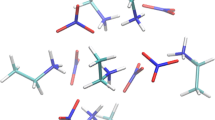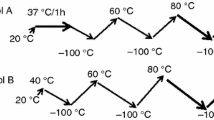Abstract
Theoretical investigations of a solute in liquid water at normal temperature and pressure can be performed at different levels of theory. Static quantum calculations as well as classical and ab initio molecular dynamics are used to completely explore the conformational space for large solvated molecular systems. In the classical approach, it is essential to describe all of the interactions of the solute and the solvent in detail. Water molecules are very often described as rigid bodies when the most commonly used interaction potentials, such as the SPCE and the TIP4P models, are employed. Recently, a physical model based upon a cluster of rigid water molecules with a tetrahedral architecture (AB4) was proposed that describes liquid water as a mixture of both TIP4P and SPCE molecular species that occur in the proportions implied by the tetrahedral architecture (one central molecule versus four outer molecules; i.e., 20% TIP4P versus 80% SPCE molecules). In this work, theoretical spectroscopic data for a peptide strand were correlated with the structural properties of the peptide strand solvated in water, based on data calculated using different theoretical approaches and physical models. We focused on a particular peptide strand, KRFK (lysine-arginine-phenylalanine-lysine), found in the thrombospondin TSP-1, due to its interesting properties. As the activity and electronic structure of this system is strongly linked to its structure, we correlated its structure with charge-density maps obtained using different semi-empirical charge Qeq equations. The structural and thermodynamic properties obtained from classical simulations were correlated with ab initio molecular dynamics (AIMD) data. Structural changes in the peptide strand were rationalized in terms of the motions of atoms and groups of atoms. To achieve this, conformational changes were investigated using calculated infrared spectra for the peptide in the gas phase and in water solvent. The calculated AIMD infrared spectrum for the peptide was correlated with static quantum calculations of the molecular system based on a harmonic approach as well as the VDOS (vibrational density of states) spectra obtained using various classical solvent models (SPCE, TIP4P, and AB4) and charge maps.








Similar content being viewed by others
References
Leung LL (1984) Role of thrombospondin in platelet aggregation. J Clin Invest 74:1764
Bornstein P (2001) Thrombospondins as matricellular modulators of cell function. J Clin Invest 107:929
Lahav J (1993) The functions of thrombospondin and its involvement in physiology and pathophysiology. Biochem Biophys Acta 1182:1–14
Kyriakides TR, Zhu YH, Smith LT, Bain SD, Yang Z, Lin MT, Danielson KG, Lozzo RV, LaMarca M, McKinney CE, Ginns EL, Bornstein P (1998) Mice that lack thrombospondin 2 display connective tissue abnormalities that are associated with disordered collagen fibrillogenesis, an increased vascular density, and a bleeding diathesis. J Cell Biol 140:419–430
Lawler J, Sunday M, Thibert V, Duquette M, George EL, Rayburn H, Hynes RO (1998) Thrombospondin-1 is required for normal murine pulmonary homeostasis and its absence causes pneumonia. J Clin Invest 101:982–992
Adams JC, Lawler J (2004) The thrombospondins. Int J Biochem Cell Biol 36:961–968
Tschoepe D, Schultheib HP, Kolarov P, Schwippert B, Dannehl K, Nieuwenhuis HK, Kehrel B, Strauer B, Gries FA (1993) Platelet membrane activation markers are predictive for increased risk of acute ischemic events after PTCA. Circulation 88:37–42
Adams JC (1997) Thrombospondin-1. Int J Biochem Cell Biol 29:861–865
Yehualaeshet T, O’Connor R, Green-Johnson J, Mai S, Silverstein R, Murphy-Ullrich JE, Khalil N (1999) Activation of rat alveolar macrophage derived L-TGF-β1 by plasmin requires interaction with TSP-1 and the TSP-1, cell surface receptor CD36. Am J Pathol 155(3):841–851
Solange M, Ribeiro F, Poczatek M, Schultz-Cherry S, Villain M, Murphy-Ullrich JE (1999) The activation sequence of thrombospondin-1 interacts with the latency-associated peptide to regulate activation of latent transforming growth factor-beta. J Biol Chem 274:13586–13593
Yee KO, Streit M, Hawighorst T, Detmar M, Lawler J (2004) Expression of the type-1 repeats of thrombospondin-1 inhibits tumor growth through activation of transforming growth factor-beta. Am J Pathol 165:541–552
Kondou H, Mushiake S, Etani Y, Miyoshi Y, Michigami T, Ozono K (2003) A blocking peptide for transforming growth factor-beta1 activation prevents hepatic fibrosis in vivo. J Hepatol 39:742–748
Ribeiro SMF, Poczatek M, Schultz-Cherry S, Villain M, Murphy-Ullrich JE (1999) The activation sequence of thrombospondin-1 interacts with the latency-associated peptide to regulate activation of latent transforming growth factor-beta. J Biol Chem 274:13586–13593
Crawford SE, Stellmach V, Murphy-Ullrich JE, Ribeiro SMF, Lawler J, Hynes RO, Boivin GP, Bouck N (1998) Thrombospondin-1 is a major activator of TGF-beta1 in vivo. J Cell 93:1159–1170
Rappé AK, Goddard III WA (1991) Charge equilibration for molecular dynamics simulation. J Phys Chem 95:3358–3363
Rick SW, Stuart SJ, Berne BJ (1994) Dynamical fluctuating charge force fields: application to liquid water. J Chem Phys 101(7):6141–6156
Harder E, Kim B, Friesner RA, Berne BJ (2005) Efficient simulation method for polarizable protein force fields: application to the simulation of BPTI in liquid water. J Chem Theory Comput 1:169–180
Pal SK, Zewail AH (2004) Dynamics of water in biological recognition. Chem Rev 104:2099–2123
Ohno K (1964) Some remarks on the Pariser–Parr–Pople method. Theor Chim Acc 2:219–227
Klopman G (1965) A semi empirical treatment of molecular structures. III. Equipotential orbitals for polyatomic systems. J Am Chem Soc 87:3300–3030
DasGupta A, Huzinaga S (1974) New developments in CNDO molecular orbital theory. Theor Chem Acc 35:329–340
Nishimoto K, Mataga N (1957) Electronic structure and spectra of nitrogen heterocycles. Z Phys Chem 13:140–157
Amrani M, Bendeddouch D, Bormann D, Krallafa A (2008) Isothermal isobaric molecular dynamics simulation of water. J Mol Struct THEOCHEM 867:39–41
Ryckaert J-P, Ciccotti G, Berendsen HJC (1977) Numerical integration of the Cartesian equations of motion of a system with constraints: molecular dynamics of n-alkanes. J Comput Phys 23(3):327–341
Nose S, Yonezawa F (1985) Isothermal–isobaric computer simulations of melting and crystallization of a Lennard-Jones system. Solid State Commun 56:1009–1013
Hoover WG (1985) Canonical dynamics: equilibrium phase-space distributions. Phys Rev A 31:1695–1697
Parrinello M, Rahman A (1981) Polymorphic transitions in single crystals: a new molecular dynamics method. J Appl Phys 52:7182–7190
Rappé AK, Casewit CJ, Colwell KS, Goddard III WA, Skiff WM (1992) UFF, a full periodic table force field for molecular mechanics and molecular dynamics simulations. J Am Chem Soc 114:10024–10035
Mulliken RS (1955) Electronic population analysis on LCAO-MO molecular wave functions. I. J Chem Phys 23:1833–1840
Löwdin PO (1950) On the non‐orthogonality problem connected with the use of atomic wave functions in the theory of molecules and crystals. J Chem Phys 18:365
Schmidt MW, Baldridge KK, Boatz JA, Elbert ST, Gordon MS, Jensen JH, Koseki S, Matsunaga N, Nguyen KA, Su S, Windus TL, Dupuis M, Montgomery JA (1993) General atomic and molecular electronic structure system. J Comput Chem 14:1347–1363
Chekirou N, Krallafa A, Bormann D (2005) Theoretical investigations and mechanisms of the inclusion processes of bi(3-sulfonatophenyl) (4-tert-butylphenyl) phosphine in the β-cyclodextrin. J Incl Phenom Macrocycl Chem 53:89–95
Berendsen HJC, Grigera JR, Straatsma TP (1987) The missing term in effective pair potential. J Phys Chem 91:6269–6271
Jorgensen WL, Chandrasekhar J, Madura J, Impey R, Klein ML (1983) Comparison of simple potential functions for simulating liquid water. J Chem Phys 79:926–935
Geerlings P, De Proft F, Langenaeker W (2003) Conceptual density functional theory. Chem Rev 103:1793–1873
Parr RG, Yang W (1989) Density-functional theory of atoms and molecules. Oxford University Press, New York, pp 3–325
Parrinello M, et al. (2017) CPMD software. IBM Corporation/Max Planck Institute, Armonk/Stuttgart
Lee C, Yang W, Parr RG (1988) Development of the Colle–Salvetti correlation-energy formula into a functional of the electron density. Phys Rev B 37:785–789
Becke AD (1988) Density-functional exchange-energy approximation with correct asymptotic behavior. Phys Rev A 3038:3098
Vanderbilt D (1985) Optimally smooth norm-conserving pseudopotentials. Phys Rev B 32:8412
Humphrey W, Dalke A, Schulten K (1996) VMD: visual molecular dynamics. J Mol Graph 14:33–388416
Gongalves S, Bonadeo H (1992) Vibrational densities of states from molecular-dynamics calculations. Phys Rev B 46:12019–12021
Gaigeot M-P, Martinez M, Vuilleumier R (2007) Infrared spectroscopy in the gas and liquid phase from first principle molecular dynamics simulations: application to small peptides. Mol Phys 105(19–22):2857–2878
Cimas A, Vaden TD, de Boer TS, Snoek LC, Gaigeot M-P (2009) Vibrational spectra of small protonated peptides from finite temperature MD simulations and IRMPD spectroscopy. J Chem Theor Comput 5:1068–1107
Torii H, Tasumi M (1992) Model calculations on the amide‐I infrared bands of globular proteins. J Chem Phys 96:3379
Gaigeot MP, Vuilleumier R, Sprik M, Borgis D (2005) Infrared spectroscopy of N-methylacetamide revisited by ab initio molecular dynamics simulations. J Chem Theory Comput 1:772
Acknowledgements
The authors are deeply grateful to the University of Reims Champagne Ardennes (URCA, France) for providing us with computational resources and time on the Romeo cluster. We are equally grateful to the University of Oran (Algeria) for assigning us computational resources and time on Haytham at the UCI (Unité de Calcul Intensif).
Author information
Authors and Affiliations
Corresponding author
Rights and permissions
About this article
Cite this article
Taleb Bendiab, W., Benomrane, B., Bounaceur, B. et al. Structure and dynamics of the peptide strand KRFK from the thrombospondin TSP-1 in water. J Mol Model 24, 54 (2018). https://doi.org/10.1007/s00894-018-3583-1
Received:
Accepted:
Published:
DOI: https://doi.org/10.1007/s00894-018-3583-1




